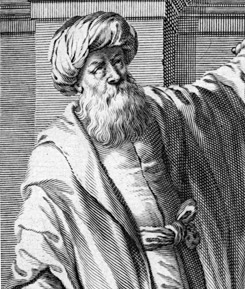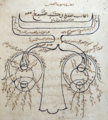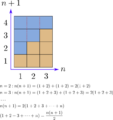Ibn al-Haytham facts for kids
Quick facts for kids
Alhazen
Ḥasan Ibn al-Haytham |
|
|---|---|
| ابن الهيثم | |
 |
|
| Born | c. 965 (c. 354 AH) |
| Died | c. 1040 (c. 430 AH) (aged around 75) |
| Known for | Book of Optics, Doubts Concerning Ptolemy, Alhazen's problem, analysis, Catoptrics, horopter, Spherical aberration, intromission theory of visual perception, moon illusion, experimental science, scientific methodology, animal psychology |
| Scientific career | |
| Fields | Physics, mathematics, astronomy |
Ḥasan Ibn al-Haytham (also known as Alhazen) was a brilliant scientist from the Islamic Golden Age. He was born around 965 CE in what is now Iraq. He was a true polymath, meaning he was an expert in many different subjects. He made huge discoveries in physics, especially in the study of optics (how light works). He also excelled in mathematics and astronomy.
Alhazen is often called "the father of modern optics." He was the first to correctly explain how we see things. He showed that vision happens when light bounces off objects and then enters our eyes. He also believed that our brain plays a big role in how we see. Alhazen was also a pioneer of the scientific method. This means he believed that ideas should be tested with experiments. He did this centuries before many European scientists. His most famous work is the Book of Optics, written between 1011 and 1021. This book was very important and influenced later scientists like Isaac Newton and Galileo Galilei.
Contents
Who Was Alhazen?
Ibn al-Haytham, or Alhazen, was born in Basra, a city in modern-day Iraq, around 965 CE. As a young man, he was interested in religion and serving his community. However, he soon became fascinated by mathematics and science. He even held an important job as a vizier (like a minister) in Basra. He was known for his skills in applied mathematics. For example, he tried to find a way to control the flooding of the Nile River in Egypt.
Alhazen later moved to Cairo, the capital of the Fatimid Caliphate. He was given an administrative job there. However, he couldn't solve the Nile flooding problem as he had hoped. This made the ruler, Caliph al-Hakim, angry. Legend says that Alhazen pretended to be unwell to avoid punishment. He was kept under house arrest until the Caliph died in 1021. During this time, he wrote his amazing Book of Optics. Alhazen continued to live in Cairo, teaching and writing, until his death around 1040 CE.
Alhazen's Book of Optics
Alhazen's most famous work is his seven-volume book called Kitab al-Manazir, which means Book of Optics. He wrote it between 1011 and 1021. In this book, Alhazen was the first to explain that we see things because light reflects from objects and then enters our eyes. He also argued that vision is processed in the brain. This was a big step forward in understanding how we see.
The Book of Optics was translated into Latin in Europe. It became very popular during the Middle Ages. It was printed in 1572 and was read by many important thinkers. Alhazen's ideas greatly influenced the study of optics for centuries.
How We See: Alhazen's Theory
Before Alhazen, there were two main ideas about vision. One idea was that our eyes sent out rays of light to see objects. The other idea was that physical forms from objects entered our eyes. Alhazen combined ideas from both theories. He said that light and color come from every point on an object. This light then travels in straight lines to our eyes.
Alhazen realized that if every point on an object sent rays to every point on the eye, the image would be a blur. He solved this problem by suggesting that the eye only truly "sees" the light rays that hit it straight on (perpendicularly). He believed these straight rays were stronger. This idea helped him explain how a clear image is formed in our eyes. Even though his theory had some small weaknesses, it was the most complete idea of its time. It greatly influenced later scientists like Johannes Kepler.
Alhazen also did many experiments. He showed that light travels in straight lines. He experimented with lenses, mirrors, and how light bends (refraction). He studied how our eyes work and how images are formed. He even described how our two eyes work together to see depth.
The Law of Reflection
Alhazen was the first scientist to fully explain the Law of Reflection. This law describes how light bounces off a surface. He stated that the incoming light ray, the reflected light ray, and the line perpendicular to the surface (called the normal) all lie in the same flat plane. This was a very important discovery in physics.
Alhazen's Problem
In his Book of Optics, Alhazen discussed a famous problem. It's now known as Alhazen's problem. Imagine you have a circular billiard table. You want to hit a cue ball from one point so it bounces off the edge and hits another ball at a second point. Alhazen found a way to solve this using conic sections (shapes like circles, ellipses, and parabolas).
This problem was very complex. Solving it led Alhazen to discover a formula for adding up numbers raised to the fourth power. This was an early step towards what we now call calculus.
The Camera Obscura
Alhazen gave the first clear description of the camera obscura. This is a dark box or room with a small hole on one side. Light from outside passes through the hole and projects an upside-down image onto the opposite wall.
Alhazen used a camera obscura to observe a partial solar eclipse. He noticed that the image of the sun looked like a crescent moon. He explained how the size and shape of the hole, and the distance to the screen, affected the image. His work helped people understand how images are formed by light.
How We Perceive Color
Alhazen also studied how we perceive color. He explained that the light reflected from an object mixes with the object's color. Our visual system then separates the light and the color. He said that we don't just see light or color separately. Instead, our brain processes them together to understand what we are seeing.
Alhazen's Scientific Method
Alhazen was a strong believer in using experiments to find the truth. He wrote:
Therefore, the seeker after the truth is not one who studies the writings of the ancients and, following his natural disposition, puts his trust in them, but rather the one who suspects his faith in them and questions what he gathers from them, the one who submits to argument and demonstration, and not to the sayings of a human being whose nature is fraught with all kinds of imperfection and deficiency. The duty of the man who investigates the writings of scientists, if learning the truth is his goal, is to make himself an enemy of all that he reads, and ... attack it from every side. He should also suspect himself as he performs his critical examination of it, so that he may avoid falling into either prejudice or leniency.
This quote shows his dedication to questioning ideas and testing them. He used a systematic approach, changing one thing at a time in his experiments. This is a key part of the scientific method used today. He combined physics with mathematics to test his ideas about vision, light, and color.
Astronomical Discoveries
Alhazen also made important contributions to astronomy.
Doubts Concerning Ptolemy
Alhazen wrote a book called Doubts Concerning Ptolemy. In it, he criticized the famous ancient Greek astronomer Ptolemy. Ptolemy's models of how planets moved had some contradictions. Alhazen pointed these out. He believed that astronomical models should be based on real physical objects, not just imaginary points or circles. He wanted to fix and improve Ptolemy's system, not replace it entirely.
Alhazen emphasized that finding the truth is hard. He said that even great scientists like Ptolemy can make mistakes. He believed that questioning existing ideas is very important for scientific progress.
On the Configuration of the World
In this book, Alhazen described the physical structure of the Earth and the universe. He explained that the Earth is a round sphere. He believed it was stationary (not moving) at the center of the universe. This book helped spread Ptolemy's ideas to Europe.
Other Astronomical Works
Alhazen wrote many other books on astronomy. He studied the Milky Way and tried to measure its distance. He also wrote about how to find the exact direction of the Qibla (the direction Muslims face during prayer) using mathematics.
Mathematical Achievements
Alhazen built on the work of earlier mathematicians like Euclid. He helped connect algebra and geometry.
Geometry
Alhazen explored Euclidean geometry, especially the idea of parallel lines. He also tried to solve the problem of squaring the circle. This means trying to draw a square with the same area as a given circle using only a compass and straightedge. He later realized this was impossible.
Number Theory
Alhazen also worked on number theory. He studied perfect numbers. A perfect number is a positive integer that is equal to the sum of its positive divisors, excluding the number itself. For example, 6 is a perfect number because 1+2+3=6. He suggested a formula for all even perfect numbers. This formula was later proven by Leonhard Euler.
Other Important Works
Engineering
Alhazen was also an engineer. He was called to Egypt to help control the flooding of the Nile River. He planned to build a dam near the modern-day Aswan Dam. However, after studying the area, he realized it was not possible with the technology of his time.
Philosophy and Theology
Alhazen also wrote about philosophy and theology. He disagreed with the idea that nature hates a void (empty space). He used geometry to argue that space is like an imagined three-dimensional void.
He was a Muslim and believed that searching for truth and knowledge was a way to get closer to God. He also wrote about how to tell true prophets from false ones.
Alhazen's Legacy
Alhazen's work had a huge impact on science. His Book of Optics was especially important. It influenced many scientists in the Muslim world and later in Europe. Scholars like Roger Bacon, Leonardo da Vinci, and Johannes Kepler studied his ideas.
Alhazen is remembered for bringing a new focus on experiments to science. He showed the importance of testing ideas. The impact crater Alhazen on the Moon is named after him. So is the asteroid 59239 Alhazen. In 2015, the International Year of Light celebrated the 1000th anniversary of his work on optics. He is truly one of the greatest scientists in history!
Images for kids
-
The structure of the human eye according to Ibn al-Haytham. Note the depiction of the optic chiasm. —Manuscript copy of his Kitāb al-Manāẓir (MS Fatih 3212, vol. 1, fol. 81b, Süleymaniye Mosque Library, Istanbul)
-
Cover page of the Latin translation of Kitāb al-Manāẓir
List of Works
Alhazen wrote over 200 works, but only about 50 have survived. Many of them are about mathematics, astronomy, and optics. Here are some of his known works:
- Book of Optics (كتاب المناظر)
- Analysis and Synthesis (مقالة في التحليل والتركيب)
- Balance of Wisdom (ميزان الحكمة)
- Doubts Concerning Ptolemy (شكوك على بطليموس)
- On the Configuration of the World (تكوين العالم)
- On the Light of the Moon (مقالة في ضوء القمر)
- On the Nature of Shadows (كيفيات الإظلال)
- On the Rainbow and Halo (مقالة في قوس قزح)
- Treatise on Light (رسالة في الضوء)
- Treatise on Place (رسالة في المكان)
- The Model of the Motions of Each of the Seven Planets (نماذج حركات الكواكب السبعة)
See Also
 In Spanish: Alhacén para niños
In Spanish: Alhacén para niños








